11595 AN UNUSUAL CARVED WALNUT DAYBED RELATED TO A DESIGN BY THOMAS HOPE Probably Low Counties. First Quarter of the Nineteenth Century. Measurements: Height: 27 3/4″ (70.5 cm) Length: 72″ (183 cm) Depth: 26 3/4″ (68 cm) Seat height: 14″ (35.6 cm).

Research
Of walnut. The bed terminating in two carved swans flanking a conforming caned headrest, One crossbar that retains caning to headrest is an old replacement; the foot of the bed decorated by two carved figures of greyhounds on each side, all above a fluted frieze, the whole raised on eight tapering fluted legs, each headed with a square capital and terminating in a brass caster. Slots at head and bottom of seat have very old wood infills. This may suggest that a design reconfiguration occurred early on in this piece’s history. Old repairs to underside of frame. Old re-caning. Upholstered circa 40 years ago in an ochre leather, with cylindrical ochre leather pillow.
Provenance:
A Brussels Collection.
The present daybed is of an unusual design inspired by the Empire taste, combining classical sophistication with a non-urban charm. It recently left a Belgian collection and it is possible that it was made in that region.
The head of the bed is formed by two carved swans, with the caned headrest conforming to their curving necks. The swan is symbol of love and seduction much employed in the furniture of the Empire period. As an emblem adopted by the Empress Josephine, it formed the armrests of chairs and was incorporated into the ends of bedframes, in the same manner as the present piece.
Interestingly, the foot of the day bed is flanked by two recumbent greyhounds, typically symbolic of high social status. Egyptians kept greyhounds for hunting and companionship, and from the Middle Ages onward they became associated with the nobility; in the 11th century the English king Canute “enacted the first laws that restricted the ownership of Greyhounds to the aristocracy.”1 They also feature in Gothic sarcophagi as a symbol of fidelity, its most celebrated quality, lying at the head or foot of the deceased’s stone effigy, particularly in the tombs of chivalric knights who also valued that “essential virtue.”2 The tomb of Sir Thomas Cave and his wife in St. Nicholas’s at Stratford on Avon offers a fine example of a greyhound at the foot of his master (figure 1).
Interestingly, the greyhound is also connected with sleep and, in this case, is employed to evoke Endymion, a Greek shepherd who was so beautiful that he was granted eternal sleep by Zeus so he would not age. The youth is portrayed in art reclining in a peaceful slumber with his hound resting alongside him. The greyhound was used in Endymion’s portraits as early as the 2nd century CE, as seen in an ancient Roman marble relief discovered in the early 18th century (figure 2). A life-size version of this scene was created by the sculptor Antonio Canova for the 6th Duke of Devonshire, who “regarded it as his greatest sculptural treasure;” here Endymion is depicted in the posture one would adopt on a daybed, with attendant greyhound at one’s feet (figure 3).
The form of this daybed is based on ancient banqueting couches (lectus) found in Greek and Roman dining rooms (triclinium), which became popular during the Empire period. As one of the most important rooms of an ancient home, the dining room was highly decorated with floor mosaics, wall paintings and luxurious furnishings and tableware. Lecti were almost exclusively intended for men during the meal and the after-dinner drinking reception, or symposium; in Rome, elite women were invited to join. The beds were outfitted with sumptuous cushions and pillows, with food and drink placed on small adjacent tables. Etiquette maintained that the men recline on their left sides and use their right hands to eat and drink. The center of the room was left open for serving and entertainment. An example an ancient couch dating from the early 1st century BC is today in the collection of the National Bardo Museum, Tunis (figure 4).
Interestingly, the present daybed is related to designs by the Anglo-Dutch banker, collector and theorist, Thomas Hope (1769-1831), published in his influential work Household Furniture and Interior Decoration (1807); Nos. 2 and 3 of Plate 28 (figure 5) are described as “Side and end of a couch: “a greyhound lies watching on the footboard, after the manner of similar animals on Gothic sarcophagi.” Hope’s finely executed illustrations proved to be one of the most significant influences on English furniture design in the early years of the nineteenth century.3 The book was widely disseminated and it is possible that the designer of this daybed was inspired by Hope’s ideas.
Another day bed in the manner of Hope to also incorporate greyhounds lying across the head and footboards, is found in the Museum of Fine Arts, Boston (figure 6).
Footnotes:
- Branigan, Cynthia A. The Reign of the Greyhound. New York: Howell Book House, 2003.
- Thomas, Keith V. Man and the Natural World: Changing Attitudes in England, 1500-1800. London: Allen Lane, 1983.
- E.T. Joy, English Furniture 1800-1851, London (1977), pp. 46-63.
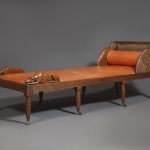
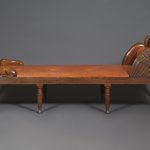
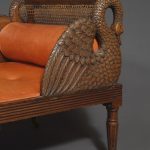
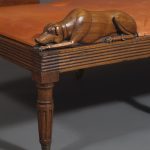
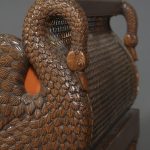

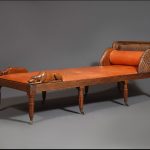
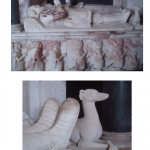
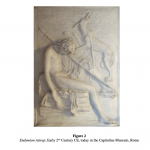
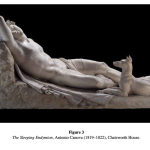
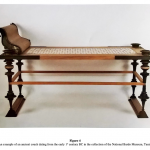


Comments are closed.